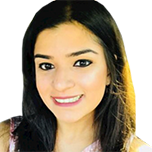What does Joe Biden’s $3trn infrastructure plan mean for your money?
Joe Biden is set to announce a further $3trn of public stimulus in the US. Saloni Sardana looks at what’s on the table, and what effect it could have on the markets.


One of the biggest debates in markets right now is over precisely what effect America’s $1.9trn coronavirus stimulus package will have on growth, inflation and debt levels.
Yet US president Joe Biden is already looking to the next level. This week – tomorrow, in fact – he plans to unveil a $3trn “Build Back Better” proposal, which includes his flagship infrastructure vision and much more. But what exactly does it involve? And what might it mean for your money?
The plan will be split into two legislative proposals, White House Secretary Jen Psaki said on Sunday. The first part of the plan – the part that’s due to be officially unveiled on Wednesday – will deal with Biden’s infrastructure and investment vision. This will include investments in clean energy, manufacturing, 5G mobile technology – all the “on-trend” sectors.
MoneyWeek
Subscribe to MoneyWeek today and get your first six magazine issues absolutely FREE

Sign up to Money Morning
Don't miss the latest investment and personal finances news, market analysis, plus money-saving tips with our free twice-daily newsletter
Don't miss the latest investment and personal finances news, market analysis, plus money-saving tips with our free twice-daily newsletter
Meanwhile, the second part of the plan – to be announced in a few weeks – is being touted as the “social infrastructure” section. This includes proposals for free community college and universal pre-kindergarten, according to the New York Times, as well as moves to increase the participation of women in the workforce.
The political logic behind the split is pretty self-explanatory. Prioritising the “roads and bridges proposal” (as it’s been nicknamed), will make it easier to get Republican backing. Given the razor slim-majority Democrats hold in the Senate, that matters. Combined, the two proposals add up to more than $3trn more in public spending.
At least $1trn will be earmarked for building and repairing physical infrastructure with a focus on climate change, says the New York Times. Biden’s election campaign pledges also emphasised a shift towards renewable energy and electric vehicles.
The proposals are likely to be funded by tax rises
The idea of investing in improving and upgrading America’s infrastructure (physical infrastructure, at least) is one of the rare things that both Democrats and Republicans agree on. However, the sticking point is also clear: how will it be paid for?
During the election campaign, Biden proposed some tax rises to at least partly fund these proposals. And both White House Secretary Jen Psaki and Treasury Secretary Janet Yellen reiterated this view last week. But what sort of taxes are we talking about?
Biden campaigned for raising corporate taxes from the country’s current level of 21% (corporation tax was lowered under Donald Trump) to 28%. Other measures include increasing the top tax rate for the richest income bracket from 37% to 39.6% as well as increasing capital gains taxes on millionaires. He has, however, also pledged that households bringing in less than $400,000 a year will not be paying more in any federal taxes being pencilled by the White House. Whether or not that turns out to be true is another matter.
Officials are also looking at where cuts could be made in other areas. One idea is to have Medicare, America’s national health insurance programme, negotiate the cost of prescription drugs direct with pharmaceutical firms. Officials are also looking at whether to extend some 2017 tax breaks on business investment – due to expire soon – to woo industry.
Will the plan be approved?
Of course, we’ve had American “infrastructure weeks” coming out of our ears – Trump notably kept talking about it but it never came to anything. So will this make it any further than the drawing board?
Getting bipartisan approval for the plan certainly won’t be easy. Republicans strongly oppose tax rises, suggests Aric Newhouse, the National Association of Manufacturers’ senior vice president for policy and government relations. “That’s the kind of thing that can just wreck the competitiveness in a country,” he says. And Newhouse is not alone. Senate Republican leader Mitch McConnell has described the plan as a “Trojan horse” for huge tax rises.
However, the Democrats do have a majority – it might be a slim one, but the proposals could potentially be approved without Republican support, just as the $1.9trn rescue plan was. The latter was funded by federal borrowing in a process known as “budget reconciliation”, which is a way of garnering fast-track approval for US laws. Current Senate rules usually require most laws to receive a majority of at least 60 votes, meaning any law being passed today would usually need the votes of all Democrats and 10 Republicans.
But the Congressional Budget Act of 1974 paves the way for a simple majority to pass certain types of legislation. Given the nature of the pandemic, the Biden administration passed the previous coronavirus package without the support of any Republicans as Democrats argued that most Americans were more concerned about getting stimulus relief than focusing on the process itself, with covid rippling across the country. That said, Democrats reportedly want Republicans to be more involved this time.
What the proposal means for your portfolio
It may be a little too early to speculate on the expected effect of the proposals, given they are yet to be announced.
But the proposals again bring inflation to the top of investors’ minds. Economists and market participants are already arguing over whether or not the previous coronavirus package is set to overheat the economy. Economist Larry Summers, who served as US treasury secretary under the Clinton administration and is hardly an ardent conservative, described the stimulus package is the “the least responsible macroeconomic package we’ve had in the last 40 years.”
So if the new $3trn package (or even part of it) makes much progress, the US bond market seems likely to come under further pressure, as expectations of higher inflation and a stronger economic rebound from the pandemic grow even stronger. Even if it is partly paid by taxes (which would offset the inflationary effect by taking money out of the economy), it’s unlikely that the entire bill could be covered that way.
That doesn’t mean the Federal Reserve will feel the need to act. The Fed has committed to keeping interest rates near zero until at least 2024, and to continue its current quantitative easing programme until maximum employment is achieved and inflation rises above 2% persistently and on average. But the central bank might need to act more aggressively if markets really start to believe that its benign view of inflation is wrong.
As for the effect on stocks, higher corporation taxes of up to 28% would dent corporate earnings by 9% in 2022, says David Kostin, chief US equity strategist at Goldman Sachs. That said, stronger growth, driven by the infrastructure spending, could partly offset this, reckons UBS’ head of equities Americas, David Lefkowitz.
But as Goldman Sachs points out, the “growth” stocks that have been driving the bull market since 2009 are more vulnerable to a rise in both corporate and taxes on foreign income compared to cyclical stocks. They are also more likely to struggle with inflation.
The companies set to benefit the most from Biden’s infrastructure plans will be industrials and material firms, says Bank of America – all cyclical stocks. Financial stocks may also benefit as rising bond yields improve the profitability of banks.
In all, if the infrastructure deal passes, the message to investors is more of the same: the “Great Rotation” from growth and tech towards cyclical, value stocks such as energy, materials, industrial and financials, will simply continue.
Get the latest financial news, insights and expert analysis from our award-winning MoneyWeek team, to help you understand what really matters when it comes to your finances.
Saloni is a web writer for MoneyWeek focusing on personal finance and global financial markets. Her work has appeared in FTAdviser (part of the Financial Times), Business Insider and City A.M, among other publications. She holds a masters in international journalism from City, University of London.
Follow her on Twitter at @sardana_saloni
-
 UK sets out crypto regulatory proposals
UK sets out crypto regulatory proposalsThe government has tabled legislation that sets out a regulatory framework for cryptocurrencies, while the regulator will consult on balancing innovation and consumer protections
-
 What does an interest rate cut mean for my pension?
What does an interest rate cut mean for my pension?Interest rates have been cut from 4% to 3.75%. For pension savers and retirees the effects of the drop will depend on the type of retirement pot they have, but could be significant.
-
 What's behind the big shift in Japanese government bonds?
What's behind the big shift in Japanese government bonds?Rising long-term Japanese government bond yields point to growing nervousness about the future – and not just inflation
-
 UK wages grow at a record pace
UK wages grow at a record paceThe latest UK wages data will add pressure on the BoE to push interest rates even higher.
-
 Trapped in a time of zombie government
Trapped in a time of zombie governmentIt’s not just companies that are eking out an existence, says Max King. The state is in the twilight zone too.
-
 America is in deep denial over debt
America is in deep denial over debtThe downgrade in America’s credit rating was much criticised by the US government, says Alex Rankine. But was it a long time coming?
-
 UK economy avoids stagnation with surprise growth
UK economy avoids stagnation with surprise growthGross domestic product increased by 0.2% in the second quarter and by 0.5% in June
-
 Bank of England raises interest rates to 5.25%
Bank of England raises interest rates to 5.25%The Bank has hiked rates from 5% to 5.25%, marking the 14th increase in a row. We explain what it means for savers and homeowners - and whether more rate rises are on the horizon
-
 UK inflation remains at 8.7% ‒ what it means for your money
UK inflation remains at 8.7% ‒ what it means for your moneyInflation was unmoved at 8.7% in the 12 months to May. What does this ‘sticky’ rate of inflation mean for your money?
-
 Would a food price cap actually work?
Would a food price cap actually work?Analysis The government is discussing plans to cap the prices of essentials. But could this intervention do more harm than good?
